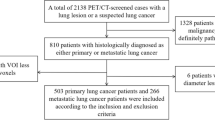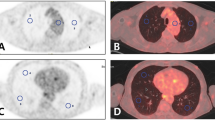Abstract
Purpose
In this study, an automated scheme for detecting pulmonary nodules using a novel hybrid PET/CT approach is proposed, which is designed to detect pulmonary nodules by combining data from both sets of images.
Methods
Solitary nodules were detected on CT by a cylindrical filter that we developed previously, and in the PET imaging, high-uptake regions were detected automatically using thresholding based on standardized uptake values along with false-positive reduction by means of the anatomical information obtained from the CT images. Initial candidate nodules were identified by combining the results. False positives among the initial candidates were eliminated by a rule-based classifier and three support vector machines on the basis of the characteristic features obtained from CT and PET images.
Results
We validated the proposed method using 100 cases of PET/CT images that were obtained during a cancer-screening program. The detection performance was assessed by free-response receiver operating characteristic (FROC) analysis. The sensitivity was 83.0 % with the number of false positives/case at 5.0, and it was 8 % higher than the sensitivity of independent detection systems using CT or PET images alone.
Conclusion
Detection performance indicates that our method may be of practical use for the identification of pulmonary nodules in PET/CT images.














Similar content being viewed by others
References
Ferlay J, Shin HR, Bray F, Forman D, Mathers C, Parkin DM (2008) GLOBOCAN 2008 v2.0, cancer incidence and mortality worldwide: IARC cancerBase no 10. http://globocan.iarc.fr
Bartjan H, Cornelia S, Hester AG, Pim AJ, Bram G et al (2010) Screening for lung cancer with digital chest radiography: sensitivity and number of secondary work-up CT examinations. Radiology 255(2):629–637
Sone S, Takashima S, Li F, Yang Z, Honda T et al (1998) Mass screening for lung cancer with mobile spiral computed tomography scanner. Lancet 351:1242–1245
National lung screening trial research team (2011) The national lung screening trial: overview and study design. Radiology 258(1):243–253
Ide M, Suzuki Y (2005) Is whole-body FDG-PET valuable for health screening? Eur J Nucl Med Mol Imaging 32(3):339–341
Lee JW, Kang KW, Paeng JC, Lee SM, Jang SJ et al (2009) Cancer screening using 18F-FDG PET/CT in Korean asymptomatic volunteers: a preliminary report. Ann Nucl Med 23(7):685–691
Wever W, Meylaerts L, Ceuninck L, Stroobants S, Verschakelen JA (2007) Additional value of integrated PET-CT in the detection and characterization of lung metastases: correlation with CT alone and PET alone. Eur Radiol 17:467–473
Niki N, Kawata Y, Kubo M (2001) A CAD system for lung cancer based on CT image. Int Congr Ser 1230:631–638
Con Lee Y, Hara T, Fujita H, Itoh S, Ishigaki T (2001) Automated detection of pulmonary nodules in helical CT images based on an improved template-matching technique. IEEE Trans Med Imaging 20(7):595–604
Suzuki K, Armato SG III, Li F, Sone S, Doi K (2003) Massive training artificial neural network (MTANN) for reduction of false positives in computerized detection of lung nodules in low-dose CT. Med Phys 30(7):1602–1617
Paik DS, Beaulieu CF, Rubin GD, Acar B, Jeffrey RB et al (2004) Surface normal overlap: a computer-aided detection algorithm with application to colonic polyps and lung nodules in helical CT. IEEE Trans Med Imaging 23(6):661–675
McNitt-Gray MF (2004) Lung nodules and beyond: approaches, challenges and opportunities in thoracic CAD. Int Congr Ser 1268:896–901
Con Way TW, Hadjiiski LM, Sahiner B, Chan HP, Cascade PN et al (2006) Computer-aided diagnosis of pulmonary nodules on CT scans: segmentation and classification using 3D active contours. Med Phys 33(7):2323–2337
Li Q (2007) Recent progress in computer-aided diagnosis of lung nodules on thin-section CT. Comput Med Imaging Graph 31(4–5):248–257
Li Q, Li F, Doi K (2008) Computerized detection of lung nodules in thin-section CT images by use of selective enhancement filters and an automated rule-based classifier. Acad Radiol 15(2):165–175
Messay T, Hardie R, Rogers S (2010) A new computationally efficient CAD system for pulmonary nodule detection in CT imagery. Med Image Anal 14(3):390–406
Teramoto A, Fujita H (2013) Fast lung nodule detection in chest CT images using cylindrical nodule-enhancement filter. Int J CARS 8(2):182–205
Guan H, Kubota T, Huang X, Zhou XS, Turk M (2006) Automatic hot spot detection and segmentation in whole body FDG-PET images. In: Proceedings of IEEE international conference on, image processing, pp 85–88
Montgomery DW, Amira A, Zaidi H (2007) Fully automated segmentation of oncological PET volumes using a combined multiscale and statistical model. Med Phys 34(2):722–736
Hara T, Kobayashi T, Kawai K, Zhou X, Ito S et al (2008) Automated scoring system of standard uptake value for torso FDG-PET. In: Proceedings of SPIE medical imaging 2008: computer-aided diagnosis, vol 6915, pp 691534-1–691534-4
Cui Y, Zhao B, Akhurst TJ, Yan J, Schwartz LH et al (2008) CT-guided, automated detection of lung tumors on PET images. In: Proceedings of SPIE medical imaging 2008: computer-aided diagnosis, vol 6915, pp 69152N-1–69152N-6
Ballangan C, Wang X, Eberl S, Fulham M, Feng D (2009) Automated detection and delineation of lung tumors in PET-CT volumes using a lung atlas and iterative mean-SUV threshold. In: Proceedings of SPIE medical imaging 2009: computer-aided diagnosis, vol 7259, pp 72593F-1–72593F-8
Teramoto A, Fujita H, Tomita Y, Takahashi K, Yamamuro O et al (2011) Hybrid CAD scheme for lung nodule detection in PET/CT images. In: Proceedings of SPIE medical imaging 2011: computer-aided diagnosis, vol 7963, pp 796335-1–796335-6
Teramoto A, Fujita H, Tomita Y, Takahashi K, Yamamuro O et al (2012) Pulmonary nodule detection in PET/CT images: improved approach using combined nodule detection and hybrid FP reduction. In: Proceedings of SPIE medical imaging 2012: computer-aided diagnosis, vol 8315, pp 83152V-1–83152V-6
Armato SG III, McLennan G, Bidaut L, McNitt-Gray MF, Meyer CR et al (2011) The lung image database consortium (LIDC) and image database resource initiative (IDRI): a completed reference database of lung nodules on CT scans. Med Phys 38(2):915–931
Kubota K, Matsuzawa T, Fujiwara T, Ito M, Hatazawa J et al (1990) Differential diagnosis of lung tumor with positron emission tomography: a prospective study. J Nucl Med 31(12):1927–1933
Duhaylongsod FG, Lowe VJ, Patz EF, Vaughn AL, Coleman RE et al (1995) Detection of primary and recurrent lung cancer by means of F-18 fluorodeoxyglucose positron emission tomography. J Thorac Cardiovasc Surg 110(1):130–139
Pauwels EK, Ribeiro MJ, Stoot JH, McCready VR, Bourguignon M et al (1998) FDG accumulation and tumor biology. Nucl Med Biol 25(4):317–322
Keyes JW (1995) SUV: standard uptake or silly useless value? J Nucl Med 36(10):1836–1839
Lowe VJ, Hoffman JM, DeLong DM, Patz EF, Coleman RE (1994) Semiquantitative and visual analysis of FDG-PET images in pulmonary abnormalities. J Nucl Med 35(11):1771–1776
Cohade C, Osman M, Marshall LN, Wahl RN (2003) PET-CT: accuracy of PET and CT spatial registration of lung lesions. Eur J Nucl Med Mol Imaging 30(5):721–726
Cristianini N, Shawe-Taylor J (2000) An introduction to support vector machines and other kernel-based learning methods. Cambridge University Press, Cambridge
Chang CC, Lin CJ, LIBSVM: A library for support vector machines. Software available at http://www.csie.ntu.edu.tw/~cjlin/libsvm/
Yamada N, Kusumoto M, Maeshima A, Suzuki K, Matsuno Y (2007) Correlation of the solid part on high-resolution computed tomography with pathological scar in small lung adenocarcinomas. Jpn J Clin Oncol 37(12):913–917
Nie Y, Li Q, Li F, Pu Y, Appelbaum D et al (2006) Integrating PET and CT information to improve diagnostic accuracy for lung nodules: a semiautomatic computer-aided method. J Nucl Med 47(7):1075–1080
Acknowledgments
The authors are grateful to C.Wei-Ping and S.Tamai from Nagoya Radiological Diagnosis Center, N. Hayashi and M. Koike from Fujita Health University, and Yoya Tomita from Mie University Hospital.
Conflict of Interest
This research is supported in part by “Computational Anatomy for Computer-aided Diagnosis and Therapy: Frontiers of Medical Image Sciences” funded by Grant-in-Aid for Scientific Research on Innovative Areas, MEXT, Japan; in part by Tateishi Science and Technology Foundation, Japan.
Author information
Authors and Affiliations
Corresponding author
Rights and permissions
About this article
Cite this article
Teramoto, A., Fujita, H., Takahashi, K. et al. Hybrid method for the detection of pulmonary nodules using positron emission tomography/computed tomography: a preliminary study. Int J CARS 9, 59–69 (2014). https://doi.org/10.1007/s11548-013-0910-y
Received:
Accepted:
Published:
Issue Date:
DOI: https://doi.org/10.1007/s11548-013-0910-y




